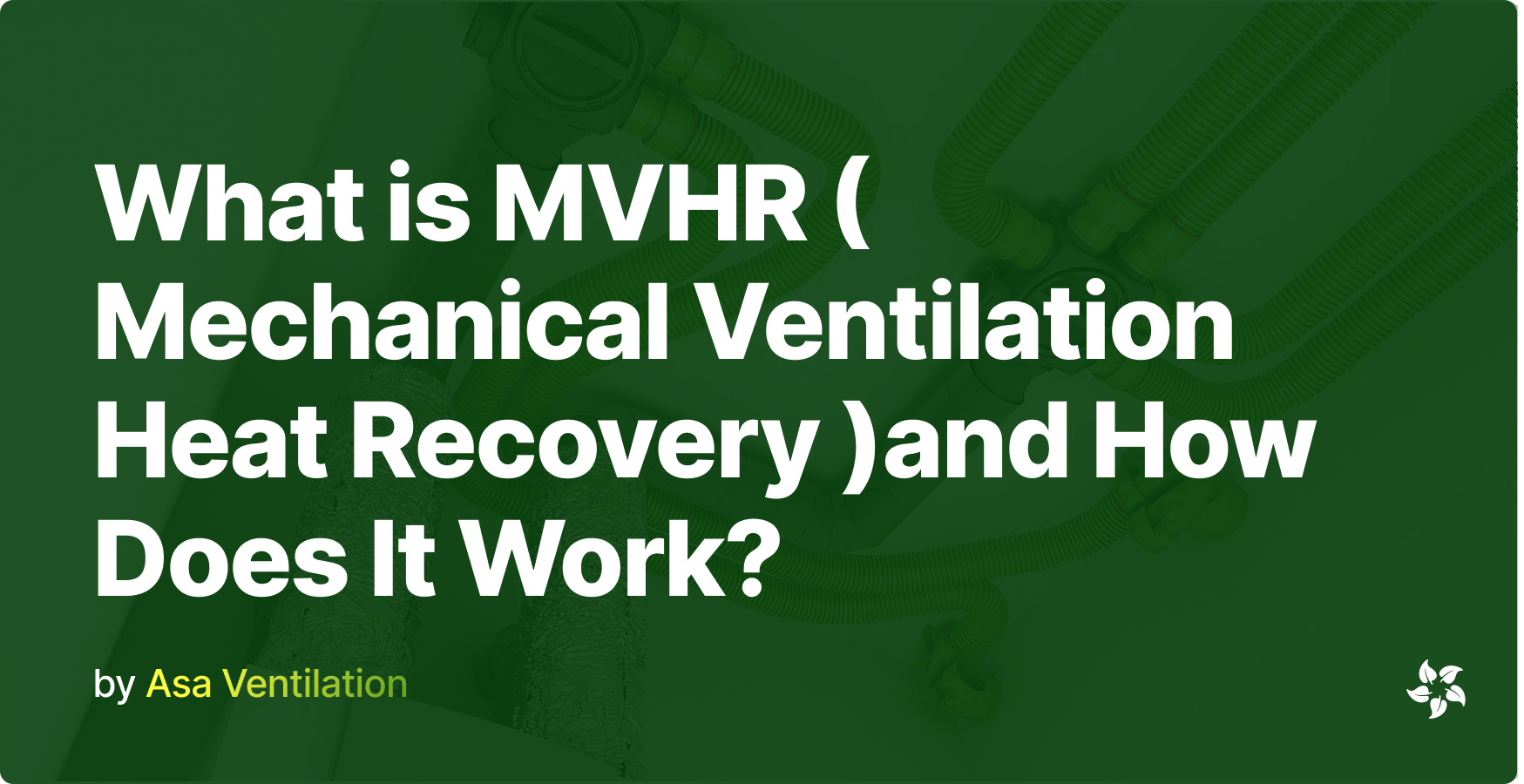When planning a modern home or renovation, one term that often comes up is MVHR – short for Mechanical Ventilation with Heat Recovery. It’s a popular choice for improving indoor air quality while maintaining energy efficiency. If you live in London, Kent, or Cambridgeshire, you’ve probably noticed the rise in demand for airtight, energy-conscious homes – and MVHR is at the heart of that trend.
This guide explains what MVHR is, how it works, its pros and cons, and whether it might be the right fit for your property. By the end, you’ll know how MVHR helps regulate temperature, improve air quality, and reduce energy bills — all while staying low maintenance.
What Is an MVHR System?
MVHR stands for Mechanical Ventilation with Heat Recovery. It’s a whole-house ventilation system that continuously extracts stale, moist air and replaces it with filtered, fresh air from outside. But what makes it clever is its ability to recover heat from the outgoing air and transfer it to the incoming air — keeping your house warm without extra energy use.
Think of it like controlled, intelligent breathing for your home. Instead of just blowing air in and out, MVHR systems manage airflow, filter particles like dust and pollen, and retain heat. The result? A healthier, more comfortable indoor climate all year round, especially in well-sealed homes where traditional ventilation methods fall short.
How Does an MVHR System Work?
MVHR (Mechanical Ventilation with Heat Recovery) systems are designed to provide a balanced, whole-house ventilation solution — constantly bringing in fresh, filtered air while removing stale, moisture-laden air. Unlike traditional extractor fans or trickle vents, MVHR systems recover heat from the outgoing air and use it to warm the incoming air, drastically improving energy efficiency.
Typically, an MVHR unit is installed in a loft space, utility room, or plant room. From there, a network of ducting runs throughout the property — often hidden above ceilings or within floor voids — distributing air to and from different rooms.
Here’s a breakdown of how the system works in detail:
🔄 1. Extraction from Wet Rooms
Stale, humid air is continuously drawn out of “wet rooms” such as bathrooms, kitchens, WCs, and utility rooms. These are the areas that typically generate the most moisture, odours, and airborne contaminants like grease or VOCs (volatile organic compounds).
By removing this air at the source, MVHR helps prevent condensation, damp, and the build-up of mould — particularly important in well-insulated or airtight homes where moisture can linger.
🌬 2. Intake of Fresh Outdoor Air
At the same time, fresh air is drawn in from outside the building. This incoming air is typically routed through an external grille, where it’s pulled into the MVHR unit via a dedicated intake duct.
Before reaching your living spaces, this air is filtered to remove common airborne pollutants like pollen, dust, insects, and urban pollution — a significant benefit for homes in busy areas like London or Cambridge, where air quality can fluctuate.
♻️ 3. Heat Recovery Process
Here’s where MVHR really shines: as the outgoing stale air passes through the MVHR unit, it travels through a high-efficiency heat exchanger. This component transfers the heat from the outgoing air to the incoming fresh air — without mixing the two streams.
In good systems, this process can recover up to 90–95% of the heat from the extracted air. That means even on a frosty morning, the air coming into your home will already be warmed using energy you’ve already paid for — significantly reducing your heating demand.
And yes, in summer, the process can help prevent overheating too. Some systems offer bypass features to prevent unnecessary heat recovery on hot days.
🏠 4. Supplying Fresh, Warm Air to Living Spaces
Once warmed and filtered, the fresh air is then distributed into your “dry rooms” — typically bedrooms, living rooms, studies, and other occupied areas. This constant supply of fresh air not only maintains a healthier indoor environment but also helps avoid the “stale” or “stuffy” feeling that many well-sealed homes suffer from.
Because the airflow is balanced (the same amount is extracted and supplied), there are no pressure issues or draughts — just a gentle, even flow that you hardly notice is there.
Additional Considerations
- Filters: Most MVHR units come with G3 or G4 filters as standard, but many allow upgrades to F7 filters for pollen and fine particles — great for allergy sufferers.
- Smart Controls: Some modern MVHR units can adjust airflow automatically based on humidity or occupancy, improving energy savings and comfort.
- Noise Levels: Properly installed, MVHR is very quiet. If you do hear noticeable sounds, it could indicate a problem with duct design, balancing, or maintenance.
Is MVHR Only for New Builds?
Nope. While MVHR is often associated with new builds or Passive Houses, it’s increasingly being installed in retrofitted properties too — especially in areas like London and Cambridgeshire where homeowners are upgrading insulation and airtightness.
The key is ensuring the home is reasonably airtight. That’s because draughty homes undermine the heat recovery part of the system. If you’re planning major renovation work, that’s a perfect time to consider integrating MVHR. If you’re unsure about airtightness requirements, we recommend a chat with our team on the About Us page – we’ll walk you through it without jargon.
Benefits of MVHR
MVHR systems aren’t just trendy – they come with real, practical benefits:
- Energy Savings: Cut heating costs by recycling heat that would otherwise escape through extractor fans or windows.
- Improved Air Quality: Say goodbye to condensation, mould, and stuffy air. MVHR provides a constant flow of clean, filtered air.
- Allergy Relief: Most systems include filters that capture pollen, dust, and airborne allergens – great for asthma sufferers.
- Low Maintenance: Besides regular filter changes, MVHR systems require very little day-to-day attention. You can learn more about care on our MVHR maintenance page.
- Quiet Operation: Modern units run quietly and continuously in the background without you even noticing.
Common Misunderstandings
- “You can’t open your windows” – You can, of course. But with fresh air constantly being circulated, you may not feel the need.
- “They’re loud” – Not at all. If your system is making noticeable noise, it might need repair or service. That’s something our London MVHR servicing team can help with.
- “Too expensive to run” – MVHR uses very little electricity and can significantly reduce your heating costs.
- “They’re just for big houses” – Not true. MVHR systems are scalable and work well in flats and smaller homes when sized correctly.
Maintenance & Longevity
To get the best from your MVHR system, it should be properly maintained. That includes replacing filters every 6 to 12 months (depending on the environment) and having the system checked professionally once a year. Our MVHR servicing in London is designed to help you stay ahead of breakdowns and performance issues.
Most systems last around 15–20 years when properly maintained. Like any mechanical system, regular upkeep can prevent small issues from becoming big problems. We also handle MVHR repairs if your unit is underperforming or showing signs of blockage or leaks.
Is It Worth It?
If you live in a well-insulated property and are looking to improve comfort, health, and energy efficiency, then yes — MVHR is absolutely worth considering. It’s an investment in your home’s long-term livability and running costs.
And if you’re unsure what system you’d need, you can try our MVHR sizing calculator (coming soon!) or simply reach out for a free assessment through our main website.
Conclusion
MVHR offers an elegant solution to modern ventilation challenges. It brings in fresh air, takes out stale air, filters the pollutants, and keeps your heat where it belongs — inside your home.
Whether you’re building from scratch or upgrading your existing property, it’s worth exploring MVHR options tailored to your space. If you’re ready to take the next step or have questions, feel free to contact our team or explore our MVHR installation services in London and nearby areas. We’re here to make the process easy and hassle-free.





